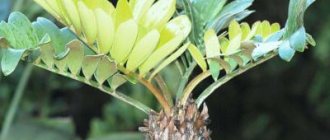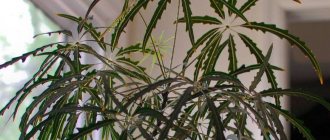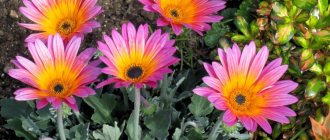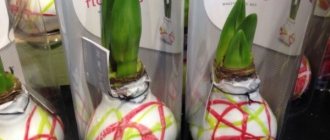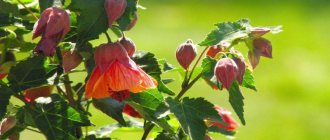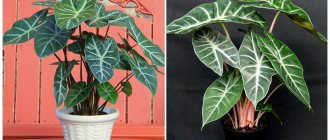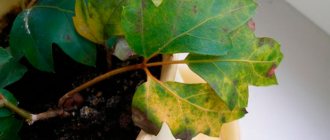Author: Elena N. https://floristics.info/ru/index.php?option=com_contact&view=contact&id=19 Category: Houseplants Published: February 09, 2019Last edits: January 11, 2021
- Growing from seeds
- Cycas turns yellow
- Drooping cycas, or wrapped cycas, or revoluta cycas (Cycas revoluta)
Cycas, or cycad, is one of the few representatives of the most ancient flora of the planet that have survived to this day. Externally, the cicada looks like a palm tree, but it is not a palm tree. Cycad is an intermediate link between ferns and ginkgo. Growing cycads at home is a rather lengthy process. There is another difficulty: an adult plant requires a lot of space, and you must take this into account.
In our article you will find recommendations for growing cycas indoors. From it you will learn:
- what types of cycads are there;
- how does the cicada reproduce;
- how to care for a cycad;
- what problems can occur in cicada and how to deal with them.
Planting and caring for cycas
- Flowering: the plant is grown as an ornamental foliage plant.
- Lighting: bright diffused light or partial shade.
- Temperature: during the growing season - normal for residential premises, in winter - not lower than 15 ˚C.
- Watering: moderate in summer, scanty in winter.
- Air humidity: high – 70-80%. It is recommended to frequently spray the leaves with water and wipe with a damp sponge, as well as wrapping the trunk with damp sphagnum moss.
- Feeding: during the period of active growth, once a month with organic fertilizers that do not contain potassium and magnesium: a solution of mullein or horse manure. Mineral fertilizers are not suitable for cicada.
- Dormant period: relative, from late autumn to early spring.
- Replanting: young plants - once every 2-3 years, it is better not to replant adults, but annually remove the top 5 cm thick layer of substrate from the pot and lay fresh soil.
- Reproduction: by lateral offspring, if any. Seed propagation is for specialists.
- Pests: scale insects, aphids, mealybugs, spider mites.
- Diseases: root rot, caudex rot, chlorosis.
Read more about growing cycas below.
plant (lat. Cycas) , or cycad , or sago palm , belongs to the only genus of gymnosperms of the Cycas family, which, according to various sources, combines from ninety to two hundred species. The range of this genus extends to Asia - from India to Japan, to the Pacific islands - Fiji, Samoa, Mariana and Madagascar. The remains of these plants were found in sediments of the earth's crust of the Mesozoic period. And although many representatives of cycads no longer exist in nature, the cycas genus continues to live solely due to its unpretentiousness. Today, the cicas palm tree is a desirable and expensive decorative element at home.
How to replant a plant
The description of the flower states that the young plant is replanted once a year, in the spring. Older specimens are replanted as the flower grows out of the pot. The average growth period in one pot is 5-6 years. If the cycas has grown very large and tall, then you don’t have to replant the flower, but just update the top layer of soil.
The root system of a flower is very delicate, so when transplanting a flower you need to handle it very carefully. There is no need to clear the old soil from the roots; just shake the earthen ball slightly.
When replanting a cicada, take a pot that is larger in size than the old one. But you cannot replant cycas into a pot that is too large, because the soil may become acidic over time and the flower may die. That is why for cycas they take light soil, which will freely allow water and air to pass through.
The best substrate for a flower is a mixture of sand, peat, humus, turf and leaf soil. Be sure to put drainage at the bottom so that excess moisture goes into it. The cone from which the flower leaves grow must remain above ground level; it cannot be covered with substrate.
Botanical description
In appearance, the cycas flower is similar to a palm tree - a tree from two to fifteen meters high with a fairly thick trunk. With a three-meter height, the cicada's trunk can reach a meter in thickness in girth. The trunk is “clad in a shell” from the remains of dead leaves. Cycas leaves, pinnate or double pinnate, similar to fern leaves, grow from the top of the trunk. The cicada lives for more than a hundred years. The home cycas grows in height only up to half a meter or up to 80 cm, and in one year it gains no more than three centimeters in height and produces only one row of leaves, at first soft and slightly pubescent, bright green in color, and over time becoming darker, hard, bare and glossy.
- Types of indoor trees
The indoor cycas flower looks more like a bush than a tree, and despite the fact that many consider the plant to be a palm tree - the name itself comes from the ancient Greek word kykas, which means “palm tree” - it has nothing to do with palm trees, but is related with ferns. Due to its slow growth, the plant is often grown as a bonsai. Cycas blooms at home very rarely. In female plants, large orange seeds are formed in cones at the top of the trunk, reaching from 3 to 5 cm in length, but to obtain seeds suitable for propagation, greenhouse conditions and the efforts of an experienced specialist are required.
Carrying out irrigation work
It is recommended to avoid excessive soil moisture. The plan in the warm part of the year is once every 5-7 days, in the winter season - once every 10-14 days. These are approximate dates.
Additionally, watch for dryness in the pot. When the outer layer dries, watering is required. If, after the appointed time, the soil composition is still moistened, then the application of liquid can be postponed.
It is important to maintain high air humidity of about 70%. To increase its level, the foliage is systematically sprayed from a spray bottle, wrapped in damp moss and cleaned of dirt with a soft cloth.
Caring for a cicada at home
Growing conditions
Before growing cycas, find a place in your apartment worthy of this plant, and if you decide to buy an already mature specimen, keep in mind that you will need a lot of space. Indoor cycas is a light-loving plant, but direct sun exposure of the leaves shortens their life and deprives them of their attractiveness. The cycas also grows in partial shade, but the lack of lighting slows down the process of formation of new leaves, and the cycas is in no hurry to grow anyway. The temperature regime, usual for our apartments, is quite suitable for the cycas; in winter, the indoor plant cycas prefers coolness, but the thermometer should not fall below 15 ºC.
Caring for cycas consists primarily of properly organized watering of the plant. In summer, soil moisture in the pot should be moderate; in winter, watering is reduced, and the amount of water required for moistening is directly dependent on the temperature in the room: the cooler the room, the less water is needed and the less often the cicada should be watered. For irrigation, use soft, settled water at room temperature or a couple of degrees warmer. Try to avoid getting water into the crown of the plant.
Air humidity for cycas requires increased - 70-80%, this can be achieved by frequently spraying the leaves with settled water, wrapping the trunk with damp moss and frequently wiping the leaves with a damp sponge.
Fertilizer
Caring for the cycas palm tree involves feeding the plant once a month during the period of active growth with organic fertilizers that do not contain magnesium and potassium salts. The best fertilizers for cycas are mullein or horse manure diluted in water. Cycas does not tolerate mineral fertilizers.
Transfer
Young cycas are replanted once every 2-3 years; it is not recommended to disturb adult plants by replanting them again, so change the pot of the plant only if it has become obviously small for the cycas. The cycas needs a pot only 2-3 cm in diameter larger than the diameter of the plant trunk, and the depth of the vessel should be equal to 2-2.5 times its diameter. That is, if you need a pot with a diameter of 15 cm, then its depth should be 30-35 cm. Cycas prefers neutral or slightly acidic soil, with good water permeability: water should pass through the soil and flow into the pan in a matter of seconds. To increase water permeability, the soil for cycas is made of pumice, coarse perlite, very coarse sand or coarse peat.
- Types of epics with photos and names
Here is an approximate composition of the soil mixture that is suitable for cicada: one part pumice or slag, one part coarse pine bark, one part crushed stone or pebbles, one part coarsely crushed charcoal, one part coarse peat, one part coarse perlite and one tenth part bone meal – all this needs to be mixed, and the resulting mixture sterilized.
A properly composed permeable substrate does not eliminate the need to place a thick layer of drainage in the pot. You can replant a plant at any season, but the most suitable time for this is before the start of active plant growth - spring. Refrain from replanting cycas when young leaves are forming - they can be easily damaged. Before replanting the cycas, remove a third of its leaves, starting with the oldest ones, and when replanting, try not to damage the roots of the plant, since deformation or injury to thick roots increases the risk of cycas rot.
Conditions for growing at home
Cycas is characterized by ease of cultivation. It needs to be provided with a sufficient amount of bright light, a humidity level above average and not be flooded with water when watering. The plant adapts well to climatic conditions. And there is every reason for this: ancient cycads grew on all continents and in all climatic zones. Cycads are best suited to growing in a well-lit conservatory, but can also be placed in other rooms where there is plenty of light and space for the broad leaves.
Important! Cycas revoluta is poisonous, so do not allow pets to chew on its leaves as
your pet may die from poisoning . Thin leaf blades especially attract the attention of cats.
Choice of location and lighting
Cycas grows well in a brightly lit place, but not in direct sunlight. Rotate the pot ¼ turn weekly to ensure even development. In bright light, cycads grow thicker leaves, while in dim light they grow long, thin leaves.
Air temperature and humidity
Cycad prefers temperatures in the range of +16...+24°C. The plant can be exposed to low temperatures (down to -9°C) for a short time, but not for very long. Cycas prefer high humidity, so you may need a humidifier if the air in your home is very dry. The plant will survive quite well in low humidity, but it will not grow or develop.
Cycas breeding
Growing from seeds
You are unlikely to be able to grow cycas from seeds: seed propagation of this plant is carried out by specialists in greenhouses and nurseries, since cycas almost never blooms at home, and there is no one to pollinate flowering cycas in apartments. But if you get good seeds, soak them for a day in warm water, then spread them over perlite and press lightly into it. Germination should occur at a temperature of at least 25 ºC for two to three months. When, a month or two after germination, the seedling has formed its first leaf, the cycas from the seeds can be transplanted into soil for an adult plant.
Reproduction by cutting off shoots
Under conditions favorable for the cicada, it produces shoots on the trunk. Using a very sharp knife, trying not to damage the trunk, the shoot is cut off, all the leaves are removed from it, the cut is treated with a fungicide, then root, planted in coarse perlite or very coarse sand and watered. Do not forget to treat the cut on the trunk of the mother plant with crushed coal. The rooting offspring should be kept in partial shade at a temperature of about 30 ºC; it is important that the substrate is kept slightly moist at all times. Rooting may take 6 months to a year, but when the roots finally grow, the offspring can be carefully transplanted into the substrate for an adult cycas.
Growing cycas from seeds
It is almost impossible to obtain full-fledged cycas seeds at home, so it is better to buy them for sowing. Fresh seeds have good germination if favorable conditions are created for their germination:
- The seeds are soaked in warm (up to 35°C) water for 10-12 hours.
- The soil mixture is prepared from a mixture of peat and sand or perlite.
- Sow the seeds, lightly pressing them into the soil, and sprinkle them with a thin layer of soil.
- The germination container is covered with film
- Maintain temperature 20-25°C, soil moisture and ventilate daily.
- After 1-1.5 months, shoots will appear. The cover is removed and the container is transferred to a well-lit place.
- In the phase of 1-2 true leaves, the seedlings are transplanted into separate pots.
Pests and diseases
Of the pests, scale insects are the most dangerous for cycas, since they are protected from the action of insecticides by a waxy coating. Adults must be collected manually, and the larvae are destroyed by treating the above-ground part of the plant with contact and systemic drugs: acephate, carbaryl, pyrethrin, pyriproxyfen or other pyrethroids. Treatment is carried out in the morning or evening at temperatures below 30 ºC. Repeated treatments can be carried out at intervals of 5 to 10 days.
Cycas is affected by mealybugs, which spread throughout the plant. Collect the pests with your hands, then treat the entire plant with a preparation containing cypermethrin, not forgetting to moisten the soil in the pot with the mixture. If necessary, the treatment can be repeated after five days, the number of sprayings is up to four sessions.
If the cycas is occupied by aphids, the plant will have to be sprayed with phosphorus preparations 2-3 times at weekly intervals. And plant mites that settle in the ground part of the cycas are destroyed by triple treatment at weekly intervals with acaricidal preparations.
- Oleander (Nerium) – care, photos, types
Of the diseases of the cycas, the most often we have to deal with are rots of the roots and caudex - the lower part of the trunk. The plant must be carefully removed from the pot, the roots must be cleared of the substrate, all blackened and darkened areas must be removed, as well as soft spots with a sharp sterile knife, the cycas should be dipped in a fungicide solution for half an hour, then all sections should be sprinkled with crushed charcoal and the plant should be allowed to dry for several hours. Then the cycas needs to be planted in a fresh sterilized substrate, after dipping its roots in a solution that accelerates the root formation process.
Don’t worry if the cycas sheds all its leaves when it takes root—it makes it easier for it to survive. Worse, if rot affects the trunk from the inside, then the plant will die.
Cycas turns yellow
Most often in letters from readers there are complaints that the leaves of the cicada are turning yellow. This is a really common problem that, fortunately, can be fixed in most cases. If you don’t know what to do if the cycas turns yellow, start solving the problem by finding out the reason why the cycas turns yellow, and, as usual, there may be several reasons:
- lack of microelements;
- lack of nitrogen in the soil;
- improper lighting;
- root system injury.
In the first case, the problem may be due to the fact that you did not apply fertilizing, or it may be due to the fact that the plant is not able to absorb the applied fertilizing due to too low a temperature or due to a change in the pH value of the soil, which was caused by chronic humidification with hard water. Because of this, the roots stopped developing. If the problem is that you did not provide the plant with the necessary microelements, the problem will be solved after applying fertilizers, and the next leaves that appear on the cicada will no longer be yellow.
If the reason is a chronic violation of the conditions for keeping the cicada, the plant needs to be transplanted into new soil, and you will have to remember the rules of care. Nitrogen deficiency is eliminated by applying fertilizers containing this element, but old, yellowed leaves, alas, will no longer turn green.
As for improper lighting, here too you will have to refer to the rules for keeping the plant, because each type of cycas has its own requirements for lighting, so the leaves turn yellow not only when there is a lot of light, but in some species this happens precisely because there is little light. Sometimes the leaves of the cycas turn yellow if you take it out into the balcony or yard in the spring without first hardening it off.
The leaves of the cycas turn yellow if the plant has not been watered for a long time or, on the contrary, it has been done too often, and also if the roots of the cycas are cold or you have applied too concentrated fertilizer - the root system gives you a signal about a serious problem with yellowing leaves, and the sooner you see the signal, the easier it will be for you to fix the problem.
Cycas is drying
If the lower leaves of the cycas turn yellow and dry, then this is a natural process, and if the tips of the leaves dry out, then most likely the air in the room is too dry or you applied fertilizing in the wrong dosage. Please clarify these issues and correct any errors. Cycas is too expensive a plant to take its care lightly.
Peculiarities
- It grows very slowly, forms one corolla per year (2 blades, sometimes up to 4-5);
- Difficult to propagate (by acquired seeds or lateral shoots);
- The leaves are held for a long time, and imperceptibly the bush becomes thicker and more luxuriant. Having reached 10-15 years, the flower contains up to 15 leaves in the rosette
- The height is no more than one and a half meters; the difference from those found in the natural habitat is that a long trunk does not grow. It was called the caudex or “bump.”
So is it worth starting a culture? Is it too difficult to care for? The opinions expressed say that maintaining it is quite simple if you follow the growing tips.
Kinds
The following types of cycas are most often grown in culture:
Drooping cycas, or wrapped cycas, or revoluta cycas (Cycas revoluta)
Its homeland is Southern Japan. The trunk of this plant is up to three meters high, columnar, thick - up to one meter in diameter. The leaves are odd-pinnate, up to 2 meters long, their numerous narrow-linear, slightly bent leathery leaves are densely located, pubescent at a young age, but over time they darken, become bare and glossy. The cones of male plants are narrow-cylindrical, up to 80 cm long and up to 15 cm in diameter, female cones are loose, covered with reddish fluff. The seeds are large and orange. This species is most often grown indoors, and it was the care of the Cycas revoluta that formed the basis of our article.
Curled cycas, or snail-shaped cycas (Cycas circinalis = Cycas neocaledonica)
A plant with a columnar trunk up to three meters high and leaves reaching two meters in length, growing several in one bunch, directed upward in youth, and later located horizontally. The pinnate leaves have up to 50-60 densely spaced narrow-lanceolate leaflets on each side of the central vein, their length reaches 25 cm and width - 1.5 cm.
Cycas media
It is a palm-shaped tree up to seven meters high with feathery leaves reaching a length of 180 cm. The leaves are collected in a rosette at the top of the trunk. Male cones are small, only up to 25 cm long, female cones look like a bunch of ears of corn. In Northern Australia in the 19th century, the seeds of this cycad were used as food, but they were first subjected to special treatment due to their toxicity.
Cycas rumphii
One of the tallest species comes from Sri Lanka, its trunk reaches a height of 8 to 15 m. The leaves are pinnate, up to 2 meters long, growing in bunches. The leaves are linear-lanceolate, up to 30 cm long and up to 2 cm wide.
Siamese Cycas (Cycas siamensis)
From the savannah forests of Indochina it grows only up to 180 cm in height, and the trunk is thickened from the roots to the middle, and then becomes thinner. The leaves are pinnate, just over a meter long, with narrow-linear, pointed leaves up to 10 cm long and half a centimeter wide, bluish-white in color.
Difficulties in growing
Cycas is rarely attacked by insect pests, but some problems may be present when growing it:
- leaf curling - this is usually due to lack of light or watering;
- the leaves turn yellow - if new leaves do not appear, then you need to check the correct watering and fertilization.
Important! To avoid burning the plant's roots, never apply fertilizer to dry soil.
Caring for a cicada is not that difficult. The main thing is to follow the rules of caring for the plant, and it will delight you with abundant foliage and flowering, bringing an element of exoticism to your room.
Care
Even before purchasing any type of cicada, it is necessary to find a place in the apartment suitable for the comfortable placement of this relict beauty, since it requires a lot of space and fresh air.
In many other respects they are very easy to care for. Caring for Cicaceae at home does not require any special conditions. By carefully and timely following the rules of care, you will preserve the decorative appearance and health of your favorite plant for a long time.
Placement and lighting
The cyclade requires a lot of light and regular changes in surrounding air masses. It is best to place the plant in an open place, preferably without neighbors.
Note: The ideal location is near a window on the south side of the house. In other parts of the apartment, even in winter, the relic plant definitely needs daylight.
During the summer growing season, it would be a good idea to place the cicada on the balcony, provided there are no drafts.
Temperature
As a representative of tropical flora, the cicada responds well to an environment with a constant, relatively warm temperature. The thermometer readings should be maintained at +20-22 °C.
In winter, the temperature may be slightly lower, but never below +16 °C.
Important: Cicada reacts very poorly to sudden temperature changes and drafts.
Humidity and watering
The watering regime of Cicaceae depends on the ambient temperature - the lower the temperature, the less frequent the watering. During the growing season, the soil should be regularly, abundantly, but not excessively moistened (to avoid root rot).
Water with clean water and close to the soil, making sure that moisture does not get into the core between the leaves.
It is difficult to maintain a sufficient level of humidity in the apartment (about 80%). Use sprayers, humidifiers, or place the vase on a tray of water and pebbles.
Soil and fertilizers
For proper growth and nutrition of cicadas, light, permeable and well-aerated soil is suitable. The substrate should be slightly acidic.
Relic plants are not particularly picky about fertilizers: insufficient fertilizer is more suitable than excess fertilizer. Fertilizers can be applied during the growing season and the condition of the plants can be checked visually.
Rule! Cicaceus is only able to fully absorb nutrients in bright light. Otherwise, the dose of fertilizer should be reduced to half the amount recommended on the package.
Trimming
For the cicada, this is only a sanitary measure. To prevent rotting and infection of healthy leaves, wilted or damaged leaf blades should be regularly removed.
Chicanes do not require trimming to form the contour.
